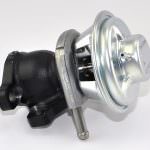Egr Valves
The component that reduces emissions through gas recirculation- 1 August 2020
- Not categorized
- Posted by SAITO
- Comments Off on Egr Valves
The EGR valve “Exhaust Gas Recirculation” has the assignment to recirculate a part of the unloading gases released by the motor (“exhausted gas”) and re-send them to the intake manifold in a percentage that oscillates among 5% and the 15% of the total one of the gases produced by the car. The purpose is to defeat the pollutants produced by vehicles : a noble goal surely, that goes in the direction pursued by the European states which try to limit the diffusion of the environment of the NOxes (nitrogen oxides), very polluting to tall pressures and temperatures.
This recirculation of the exhausted gases in the phase of unloading happens thanks to the signals given by the ECU(electronic control unit) to a solenoid valve. This last one has the function to close and open itself and regulates the passage of the gases through an exchanger which lowers the temperature of gases and puts them again
- 1 July 2020
- Not categorized
- Posted by SAITO
- Comments Off on Dump Valves
The pop-off valve is also known as air recirculation valve a or dump valve . It was born to eliminate the water hammer due to the sudden increase in pressure in the duct between the compressor and the throttle body when, with the engine under load and with turbo at high revs, the accelerator is removed or when the butterfly on the throttle body is closed . The air from the delivery duct after the compressor is recirculated in suction before the latter.
The free discharge solutions are only a free interpretation not supported by any technical reason. Of course the recirculated pop off loses the noise that many people enjoy.
For this product category SAITO proposes the pop-off valve that is mounted on the turbo 49373-03012 (OE 55243431.01) for Fiat 500, Panda, Punto, Lancia Ypsilon, Alfa Mito with Fiat SGE engine –
Garrett Performance External Wastegates GVW
Uncompromising performance!- 1 April 2016
- Not categorized
- Posted by SAITO
- Comments Off on Garrett Performance External Wastegates GVW
Wastegate Valves / Actuators
Allows turbochargers to run fast at low speeds, stabilizing the boost pressure- 1 March 2014
- Not categorized
- Posted by SAITO
- Comments Off on Wastegate Valves / Actuators
The waste gate valve was created to make the turbo run faster at low revs with a small size turbine housing, without reaching too high pressures at high rpm. In fact, a small turbine housing allows the turbo to spin sharply from the lower engine revs. Obviously when the engine expels a considerable amount of gas at the top, the narrow turbine housing becomes a bottleneck that prevents the engine from going up and down and at the same time, it makes the shaft wheel to rotate too hard. The problem is solved by providing the turbine housing with the waste gate valve, controlled by an actuator. The actuator feels the supercharging pressure through a tube connected to the compressor housing and it moves the waste gate plate opening an air inlet before the compressor wheel.
The gases and the power generated are sent directly to the evacuation so they are not released to the





